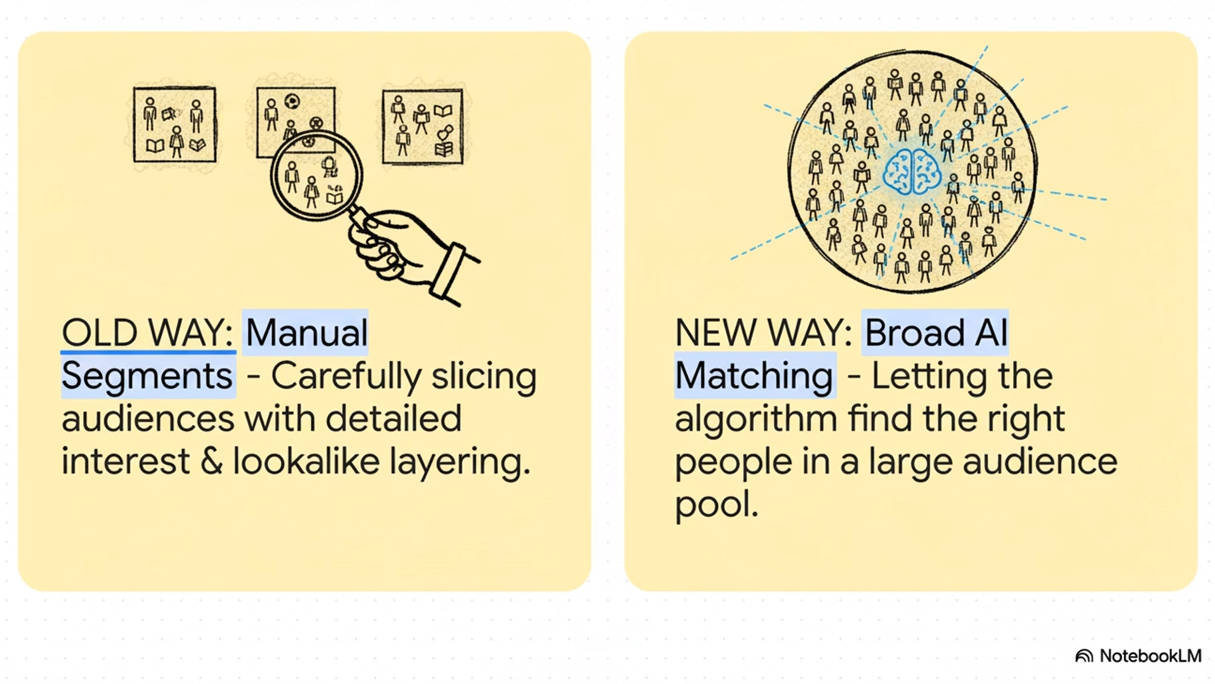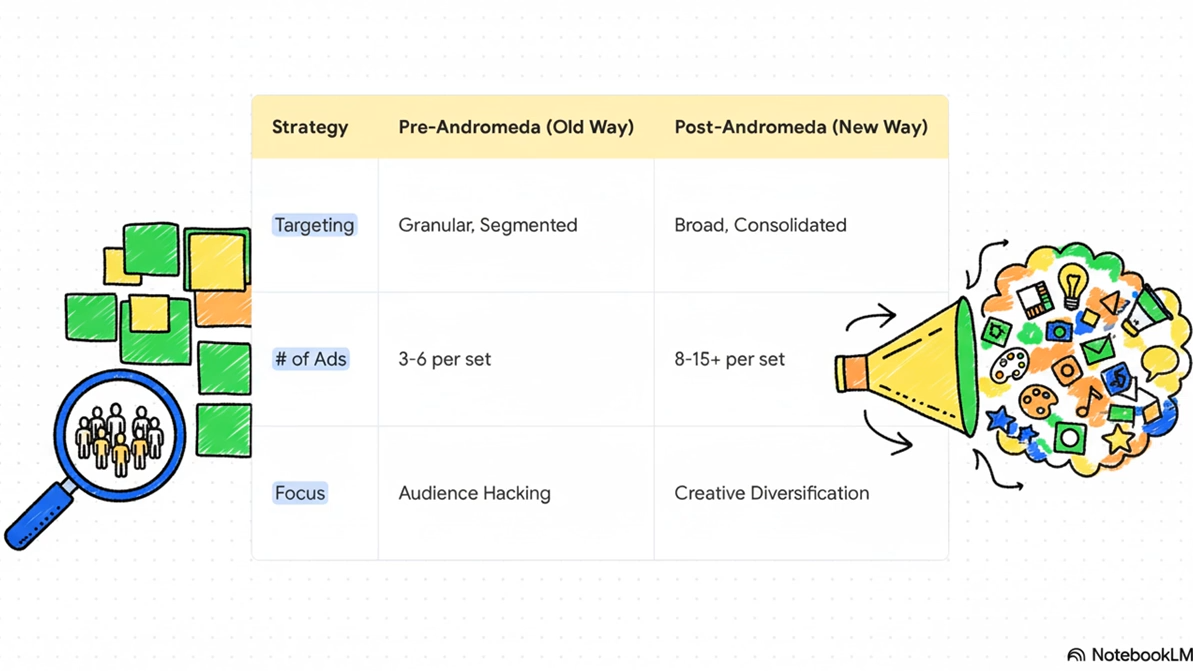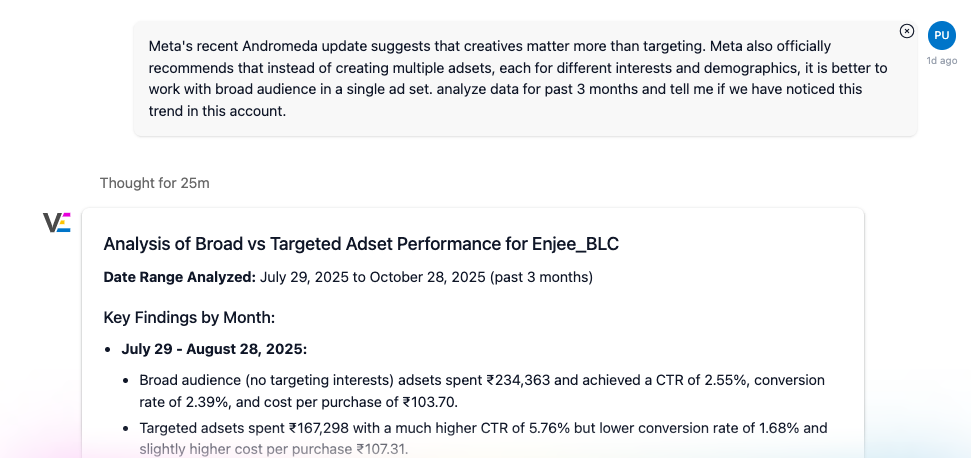Did you notice Facebook & Instagram ads went a little haywire around January or February in 2025? Reddit channels, Slack communities, and all forums were discussing the same thing. What went wrong? Why is the CPM up and why are the sales down?
If you were also part of the same bandwagon, you’ve landed at the right place. Many other advertisers are sharing similar stories and noticing similar patterns in their ad accounts. Turns out, it is due to the gradual rollout of Andromeda – Meta’s new AI-driven ad delivery system.
Basically, it was a complete overhaul of how Facebook decides which ads to show people. That’s why the old Meta ad strategies started tanking, and you noticed weird patterns in your Facebook ad accounts in early 2025.
In this post, let’s discuss what Meta’s latest Andromeda update is, how it impacted your Facebook Ads performance, and how you can overcome the losses.
How it works: The system scans millions of ads per impression, maps users and ads in a mathematical space, and finds highly specific matches (like “red flip-flops for beach trips” instead of just “shoe lovers”). It learns from your recent behavior sequences, not just your static profile.
What broke: Narrow targeting, lookalike audiences, complex campaign structures, and testing minor ad variations all stopped working. Campaigns optimized the old way saw costs double and conversions crash.
What works now: Broad targeting (entire country, minimal restrictions), 8-15 genuinely different ad concepts per campaign, simple structure (one campaign, one ad set), trusting Advantage+ automation, and refreshing creative every 1-2 weeks. Creative diversity replaced audience targeting as the main performance lever.
Bottom line: Andromeda rewards variety and punishes shortcuts. Simplify your structure, go broad, make diverse ads, let the algorithm optimize. The advertisers who adapted are seeing better results than before. Those still using 2024 tactics are struggling.
Andromeda is Meta’s new AI-driven personalized ads retrieval engine. In simpler terms, it’s the first stage of the ad delivery process that filters millions of candidate ads down to a few thousand eligible ads for each impression opportunity. Andromeda replaced Facebook’s old ad delivery system between late 2024 and early 2025.
The earlier ad delivery system struggled with explosion of ad variations from AI tools (e.g. Advantage+ creative, generative AI). Suddenly, advertisers weren’t uploading 5 ads per campaign. They were uploading 50, 100, or letting Meta’s tools generate hundreds of variations automatically.
Here, ad retrieval turned into a real “bottleneck.”
But with Andromeda, Meta is using machine learning models 10,000x larger than the previous system to scan millions of ads in milliseconds. As a result, users now see ads based on real-time behavior, context, and preferences rather than basic demographic targeting.
Here’s what changed: Instead of matching you to ads based on broad categories (“fitness enthusiast”), it now matches based on incredibly specific contexts and behaviors. Not just “this person likes fitness,” but more like “this person watches workout videos on Saturday mornings, bought protein powder three weeks ago, and just searched for home gym equipment.”
Fun fact: Meta calls Andromeda a sort of “personal concierge.” That’s because system is now modified in a way to actually interpret fine-grained interests and contexts.
And here’s the crucial part: It’s not tracking you any more than Facebook already was. Your Pixel didn’t break. Privacy settings didn’t change. Meta just got way, way better at using the data it already had.
Andromeda operates as the first stage of Meta’s ad delivery system. It’s the filter that narrows down millions of possible ads to a shortlist of candidates that might be relevant to you.
Then the ranking system takes over and picks the final winner from that shortlist. But Andromeda’s job is to make sure the right ads even make it to the consideration stage.
This is where it gets technical, but I’ll keep it simple.
Andromeda uses something called “embeddings.” Basically, it maps users, contexts, and ads into a high-dimensional mathematical space. You, as a user, have coordinates based on your interests, behaviors, and context. Every ad also has coordinates based on its content, who it’s designed for, and what it’s trying to sell.
Andromeda’s job is to find ads whose coordinates are close to yours.
This is why broad targeting works now. You don’t need to tell Facebook who to target. The algorithm is already mapping everyone in that massive mathematical space and finding the matches automatically.
Here’s where Andromeda gets really smart. It doesn’t just look at your static profile (age, location, pages you liked three years ago). It learns from the sequence and timing of your recent actions.
Did you watch a workout video, then search for protein powder, then click on a gym ad? The system understands that sequence suggests intent. You’re probably in the market for fitness products right now.
Andromeda picks up on these patterns and adjusts its recommendations in real-time. This is why the system feels more responsive than the old one. It’s constantly learning from what you just did, not just what you’ve always been interested in.
The numbers here are genuinely impressive.
Andromeda can process and evaluate tens of millions of ads at once.
It does this using hierarchical indexing and parallel processing. Instead of checking every single ad one by one, it uses smart shortcuts to eliminate huge chunks of irrelevant ads instantly, then focuses its computing power on the viable candidates.
The result: It can handle the massive explosion of ad variations without slowing down. Users don’t notice any lag. Ads still load instantly. But behind the scenes, the system is doing exponentially more work.
This is also why Meta can now recommend running 8-15+ ads per campaign without performance suffering. The old system would’ve choked on that much input. Andromeda handles it easily.

The delivery process hasn’t fundamentally changed. It’s still a multi-stage system. But each stage works differently now.
This is the new part. Andromeda scans millions of ads and builds a shortlist of a few thousand candidates that might be relevant to the current user in their current context.
It’s using all those embeddings, behavioral signals, and real-time learning to make smart filtering decisions.
The ranking system takes Andromeda’s shortlist and predicts how likely you are to take action on each ad (click, convert, engage, etc.). It considers factors like ad quality, relevance score, and bid amount.
This stage hasn’t changed as much. Meta may have updated the ranking models too (some speculation about a system called “Lattice”), but the big overhaul was in retrieval.
The highest-ranked ads go into the auction. Meta determines which ad wins based on bid, relevance, and estimated action rates. Then it gets shown to you.
The difference now: Because Andromeda built a better shortlist in stage 1, the ads making it to auction are already more relevant. So the whole system performs better end-to-end.
Here’s the thing about this new system: It thrives on having options.
If you give Andromeda 3 ads that all look similar, it groups them together and treats them as one option. You’re not giving the algorithm much to work with. But if you give it 12 genuinely different ads (different people, different messages, different formats), now it has 12 distinct options to match against different user segments.
Andromeda can figure out which ad needs to go where, but only if you provide the variety. If all your ads say basically the same thing, the algorithm can’t personalize.
Meta’s data backs this up: Advertisers using Advantage+ Creative (which generates multiple variations automatically) saw 22% higher ROAS on average. Those using AI-generated creative elements saw about 7% boost in conversions. (Read the Meta blog here)
The system rewards diversity because diversity gives it the raw material to do its job.
PS: Please don’t load 30-40 creatives in a single ad set. Remember, Meta only has a limited amount to spend daily. So, if you give the algorithm an OBSCENE amount of creatives, it have enough learning capacity to rank the angles. (Read more here)
Andromeda was specifically designed to make Advantage+ work better. Before, Advantage+ features were hit or miss. The system tried to automate decisions but didn’t have the processing power or intelligence to make great choices consistently.
Now it does. Advantage+ can automatically handle audience selection, placement optimization, and budget allocation better than most manual setups.
In Meta’s tests, campaigns using Advantage+ with broad targeting saw up to 10% lower cost per lead compared to traditional manual campaigns.
Here’s what you should actually turn on:
Alright, enough theory. Let’s talk about what actually works.
This is probably the biggest mindset shift if you have been running Facebook Ads for a while. You’ve probably been taught to segment, create tightly defined audiences, and build complex funnels.
Now, you need to shift to: One campaign per product or objective. One ad set per campaign with broad targeting. That’s it. Meta’s guidance is clear: “The focus has shifted from niche targeting to creative diversification as the best lever to find relevant audiences.”
Agencies testing this approach saw 15-17% improvement in conversion rates just from consolidating.
Why does this work? Because you’re no longer fragmenting your data across multiple ad sets. The algorithm gets all the conversion signals in one place and can optimize faster.
United States, 18-65+, all genders, no interests. Start there.
Only add exclusions or restrictions if they’re absolutely necessary. Selling maternity clothes? Fine, target women. Selling retirement planning? Maybe exclude people under 50.
But beyond obvious stuff like that, go broad.
Multiple agencies have tested narrow vs. broad and broad wins consistently now. One test showed 17% more conversions with broad targeting compared to interest-stacked audiences.
The algorithm is better at finding your customers than you are at defining them. Let it do its job.
Remember when Meta removed the limitation of max 6 ads per ad set? That’s because of Andromeda. Now the sweet spot is 8-15 ads, but they can’t all be same or similar. Instead, go for:
If your ads have the same actor in the same location, Andromeda probably groups them as one ad. Changing the script doesn’t matter. The algorithm sees through cosmetic changes.
👉 RELATED: Read about Different Types of Facebook Ads you can create today (THAT ACTUALLY WORK!)

Here’s a practical way to generate variety:
Now mix and match. You don’t need every combination, but aim for genuine variety across these dimensions.
This framework naturally creates the diversity Andromeda needs.
Sounds basic but Andromeda is only as good as the signals you give it. Make sure your Pixel is installed correctly and firing on all conversion events. Test it. Verify it’s working.
Set up Conversions API if you haven’t already. It helps Facebook track conversions that the Pixel misses due to iOS restrictions or ad blockers. Meta reports that accounts using CAPI see more stable performance.
Upload your customer lists. They’re valuable first-party data that helps the algorithm understand who converts.
Make sure your conversion events are set up properly. Are you optimizing for the right action? Purchase, lead, add to cart, whatever actually matters for your business.
Don’t stop ads in the first 48 hours. The algorithm needs 3-5 days to figure out where an ad fits. You’ll see weird stuff early on. One ad gets all the spend on day 1, then a different ad gets it on day 2.
That’s normal. It’s testing or learning phase.
An ad with $5 spend and no conversions on day 2 might find its perfect niche audience on day 5. Several Reddit users shared stories of “duds” that became winners after a week.
Judge campaign-level performance after 5-7 days, not individual ad performance after 24 hours.
Just because Meta is now promising you better results, it doesn’t mean you can let your Ad account run on autopilot mode.
Whatever you’re doing, keep track of it. Know all your Facebook Ads metrics. If CPA dipped, know why. If your CTR improved, check what finally clicked with your audience.
If you’re eager to know the “why” behind “what happened,” give Vaizle AI a go. Vaizle AI is your Meta Ads analytics agent & it understands your Meta Ads data like a real human.
All you need to do is ask a question and Vaizle AI takes time to understand the query, questions back and forth, and brings forward a comprehensive answer. In most cases, you leave with a Meta Ads insight you’d normally miss.
For example: I asked about Andromeda effect on Facebook Ads in one account. Vaizle AI conducted a comprehensive analysis and confirmed these patterns were true.

At the end of report, Vaizle AI even gave me a final conclusion & next recommended steps:

Best part? Vaizle AI starts at $1. You can claim your trial, connect a Meta Ad account, and look for an insight you’d normally miss out on.
Meta’s Andromeda update fundamentally changed how Facebook advertising works. They replaced the targeting-based system with an AI-driven personalization engine that’s way more powerful but requires a completely different strategy. If your ads stopped working in early 2025, this is why. And if you’ve read this far, you now know what to do about it.
Looking ahead, Meta will keep moving more work inside the machine. As Siddharth Dwivedi (co-founder of a growth marketing agency) points out, the early impact is already visible for analysts and buyers. The system decides more of the who, where, and when. Give it enough high-quality creative and, over time, it will learn how to assemble and test variations on its own. That future isn’t about removing marketers. It’s about changing what great marketers do.
Our job shifts from micro-targeting and toggling settings to crafting strong concepts, feeding clear data, and reading the big picture. If you embrace that shift, Andromeda is not a threat. It’s leverage. (For now!)
That’s the new game. Let’s play it well.
Meta rolled out Andromeda between late 2024 and early 2025. The rollout was phased, with some ad accounts migrating in January 2025 and others not until March or April. This uneven rollout caused confusion as advertisers experienced changes at different times.
Your ads likely stopped working because Meta’s Andromeda update changed how the algorithm evaluates campaigns. Strategies that worked before (narrow targeting, lookalike audiences, testing minor variations) became ineffective. The new system rewards broad targeting and creative diversity instead.
Run 8-15 genuinely different ad concepts per campaign. Meta removed their old “maximum 6 ads” recommendation when Andromeda launched. The key is that ads must be truly distinct (different people, settings, messages, formats), not just minor variations of the same concept.
Yes, Andromeda powers both Facebook and Instagram ad delivery. The same system makes decisions across both platforms, so all strategies that work for Facebook ads apply equally to Instagram ads.
Use broad targeting. Go as wide as possible (entire country, age range 18-65+, no interests) unless you have obvious restrictions. Agencies testing this approach saw 15-17% better conversion rates with broad targeting compared to narrow interest-based audiences.
Ad retrieval (Andromeda) is the first stage that scans millions of ads and creates a shortlist of candidates relevant to each user. Ad ranking is the second stage that predicts which ads from that shortlist are most likely to get clicks or conversions. Andromeda’s job is building a better shortlist.
Lookalike audiences technically still work but are much less powerful. The algorithm now builds its own “lookalikes” automatically using far more signals than you can manually define. Most advertisers see better results from broad targeting with conversion optimization than from manual lookalike audiences.
Ads are truly different when they have distinct people on camera, different physical settings, different core messages (not just reworded), and different formats. Ads with the same actor in the same location are considered identical by Andromeda, even with different scripts. Changing just headlines or hooks doesn’t count as a new ad.
High CPMs often indicate your ads lack creative diversity or you’re still using narrow targeting. Andromeda performs poorly when given similar ads or restrictive audience settings. Try consolidating to one broad campaign with 8-15 genuinely different ad concepts and costs typically stabilize.
One campaign per product or objective, one ad set with broad targeting, and 8-15 diverse ads within that ad set. Simple structure lets the algorithm optimize with maximum data instead of fragmenting signals across multiple ad sets.
While not strictly required, Conversions API significantly improves performance. It helps Meta track conversions the Pixel misses due to iOS restrictions and ad blockers. Better conversion data means Andromeda can optimize more effectively.
Narrow targeting will likely remain less effective. Meta invested heavily in AI infrastructure that’s designed to find audiences automatically. The system performs better with broad inputs and creative diversity than with manual audience restrictions.
Purva is part of the content team at Vaizle, where she focuses on delivering insightful and engaging content. When not chronically online, you will find her taking long walks, adding another book to her TBR list, or watching rom-coms.